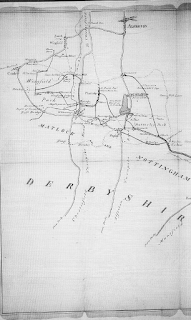Fenian
Fever
By
Angela Buckley
 |
| Smithfield Market. |
On 11 September 1867, a vigilant police
constable spotted two suspicious-looking men hanging around Smithfield Market
in central Manchester. The officer suspected them of planning to burgle a shop,
and when one of the men pulled out a gun, he arrested them. The prisoners, who
gave false names, were charged with loitering. During their detention,
communication between the police in Manchester and the Irish authorities
revealed the two men’s true identities: Colonel Thomas Kelly and Captain
Timothy Deasy of the Irish Republican Brotherhood, who were wanted on suspicion
of terrorism. Both veterans of the American Civil War, they had come to England
to take part in actions against the British government to force the issue of
home rule.
A week later, the prisoners were to be
transferred to Belle Vue Gaol, at the edge of the city.
Travelling in a
horse-drawn Black Maria with other offenders, including women, Kelly and Deasy
were accompanied by Sergeant Charles Brett, who was locked inside the van with
them. Several more officers followed behind. As the convoy passed under a
bridge at Ardwick Green, a volley of stones hit the van forcing it to stop. The
police were then quickly surrounded by armed men, who shot both the horses and
wounded at least two officers. Unable to enter the locked Black Maria, the
assailants screamed through the ventilation slot for the keys, which were held
by Sergeant Brett. In a desperate attempt to protect the prisoners on board,
especially the women, the young police officer refused to hand over the keys. A
gunman poked his rifle through the slot and shot Sergeant Brett through the
head. The bullet passed through his skull and lodged in his helmet.
 |
| Charles Brett's memorial. |
 |
| 'Manchester Martyrs'. |
Once they were released, Colonel Kelly and
Captain Deasy fled the scene. Within three days of the incident, the police had
arrested some 50 Irish men, 26 of whom were charged. Later that year, on 25
November 1867, William Allen, Michael Larkin and Michael O’Brien were hanged
for Sergeant Brett’s murder - they became known as the ‘Manchester Martyrs’.
Following the death of Sergeant Brett, ‘Fenian fever’ had spread like wildfire
throughout Britain, causing the Victorians to fear the very real threat of
Irish nationalists and their deadly campaign. This deep-seated terror would
have a dramatic impact on three Irish brothers who also stood trial for murder
in Manchester, a decade later.
On 1 August 1876, PC Nicholas Cock was
walking his beat at midnight in the township of Chorlton-cum-Hardy, about four
miles from Manchester city centre. The young officer had stopped at the
junction of West Point, where three main thoroughfares converge, to chat with
one of his colleagues and a passing law student. The three men went their
separate ways and, a few minutes later, two shots rang out in the dark. PC James
Beanland and student John Massey Simpson ran back to the junction to find PC
Cock lying on the ground in a pool of blood - he had been shot. When Nicholas
Cock later died of his injuries, a manhunt began.
On hearing the terrible news, PC Cock’s
superior, Superintendent James Bent, knew instantly who the culprits were and
he arrested three local Irish labourers soon after. The Habron brothers had
crossed the path of PC Cock many times and he had been responsible for their
being charged with drunkenness on at least two occasions. Residents of Chorlton
had even overheard the brothers threatening to do away with PC Cock. Despite
the circumstantial nature of the evidence against them, which was based on boot
prints found near the scene of the crime, Superintendent Bent managed to secure
a conviction against the youngest brother William, aged 18, who received the
death sentence. It is likely that this was only possible due to the prejudice
towards the Irish community which was still prevalent at all levels of
Victorian society. The conviction was followed by a desperate race to spare
William Habron from the gallows. Three years later, a startling confession by a
notorious career criminal finally revealed the truth about who killed Constable
Cock.
Who Killed Constable Cock? by Angela Buckley is out now in ebook and
paperback. You can find out more about Angela’s work on her website, www.angelabuckleywriter.com and on her Facebook page Victorian Supersleuth.
Images
1. Smithfield Market, Manchester. Copyright free - from author’s collection.
2. The memorial to Sergeant Charles Brett, St Ann’s church, Manchester. © A Buckley.
3. Poster commemorating the Manchester Martyrs. Source: Wikicommons.
4. Memorial to the Manchester Martyrs at Moston Cemetery. Source: Wikicommons,









